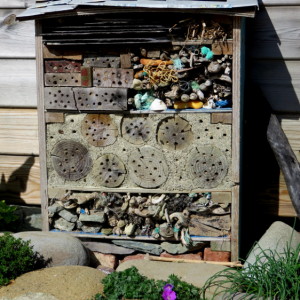To bee or not to bee
This is part of a 'bee hotel', a structure fashioned to provide nesting opportunities for solitary bees such as the red mason bee. an endangered species which is an important pollinator. It lays its eggs in the hollow stems of dead plants or in chinks and crevices of crumbling stonework (hence its name), and seals up the holes with mud. It's possible to buy or make bee 'hotels' for the purpose and this one appealed to me because it had been consructed using a jumble of beachcombed material along with sections of logs drilled with holes. The whole thing (see extra) looked attractive to the eye and indeed to the bees that I could see hovering around and exploring it.
But when I looked for advice on making my own Airbee'n'bee I found that, as is so often the case when us well-meaning humans poke our noses try to lend a hand with natural processes, it's not as simple as it appears. The jury is still out on whether providing this sort of accommodation is helpful or not. "At their worst, bee hotels may act as population sinks for bees through facilitating the increase of parasites, predators... and diseases." It seems that inviting bees to live at close quarters also attracts the pests that prey upon them, especially parasitic wasps that lay their eggs on bee larvae. You are advised that the tubes have to be made of the correct materials - plastic or glass create condensation which encourage mould. The tubes need to measure the correct size and in addition must be cleaned or replaced each year. There's a useful round-up on the subject here. In essence it seems a hotel like this is good for one season only, so - bee advised!


Comments
Sign in or get an account to comment.


